
By the mid-1990s Iron Maiden had clearly become a diminished force, but they would gamely take another crack at rebuilding their house. With this chapter in our study of Maiden History we take a look at the making of Virtual XI and the events that led to the end of the Blaze era.
On 7 September 1996 Iron Maiden’s The X Factour worldwide trek came to a close in Monterrey, Mexico. Having started in Israel and South Africa in late September and early October 1995, the tour wound its way around Europe, North America, Japan, Europe again, and then South America before the Mexico finale.
128 shows around the world over a period of one year was far beyond anything Maiden’s new singer Blaze Bayley had ever experienced or even contemplated, his previous band Wolfsbane never having played outside the UK.
“It was tough you know. Really tough. But it wasn’t just for me. I remember Dave turned to me at the end of it all and said ‘that was one of the toughest tours we’ve ever done’. And of course there was the fact that we were playing smaller shows than Maiden had played for years.”
Blaze Bayley

Iron Maiden enjoying a breather at Steve Harris’ swimming pool before their fairly intense year of touring for The X Factor in 1995-96: Janick Gers, Blaze Bayley, chief Harris himself, Nicko McBrain and Dave Murray.
On the one hand it was among Maiden’s most expansive tours ever, playing more shows in more countries than they had done since their mid-1980s height of fame, but on the other hand it had been disappointing: Except for a few notable highlights, particularly South America, Iron Maiden had not performed in venues this small since the very early 1980s.
The contrast was clear: big for Blaze was small for Maiden.
Nearly three years after Bayley had joined Maiden as the replacement for Bruce Dickinson, he had been an integral part of writing and recording The X Factor (1995) and had toured around the world with a classic metal band, capping it all with the release of Maiden’s first compilation album Best Of The Beast in September 1996.
It must have been one hell of a ride for the singer. But it must also have been a tour that gave cause for concern in the minds of band leader Steve Harris and particularly manager Rod Smallwood. Maiden’s past glories were by now only a faint memory to the public, a legend to be revisited on classic albums and the Live After Death (1985) and Maiden England (1989) videos.
FALLING DOWN
It is important to note that the decline of Iron Maiden in the 1990s did not begin with the arrival of Blaze Bayley. In fact, commercially speaking, their fortunes were already dwindling by 1988 in the United States of America, when the Seventh Son Of A Seventh Son album and tour failed to live up to their previous blockbuster success.
In the early 90s, after losing guitarist Adrian Smith, Maiden’s US popularity plummeted with No Prayer For The Dying (1990) and Fear Of The Dark (1992), a period that culminated in Dickinson’s stormy exit from the band in 1993. The new low in the Blaze era, even if US shows were smaller than ever, was the band’s diminished popularity in Europe. In their own England they would be reduced to playing theaters like London’s Brixton Academy and Nottingham’s Rock City.
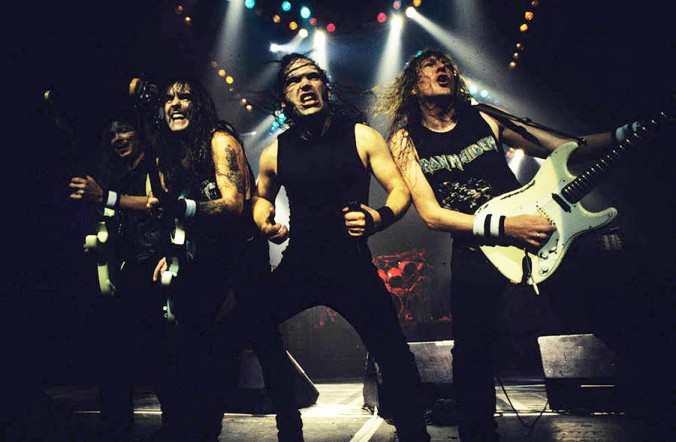
Murray, Harris, Bayley and Gers on stage during Maiden’s 1995-96 world tour in smaller venues.
Did times simply change or were Iron Maiden’s records and concerts truthfully not that good anymore? Although taste is obviously beyond debate, it is hard to ignore that Maiden albums from 1990 onwards became steadily less appreciated by fans and critics alike. In this writer’s opinion, Fear Of The Dark and The X Factor fell far short of living up to Iron Maiden’s legacy, and they also failed to find other compelling musical avenues to explore.
As the band reconvened in the summer of 1997 to start writing yet another album, the pressure must have been nothing compared to the tense creation of The X Factor three years earlier. For one thing, they had a settled line-up of members that wanted nothing more than to actually be in Iron Maiden. But the expectactions of the public would also be quite sober in light of what the band had recently produced, and even more so in the light of what a certain someone else was doing.
THE OTHER MAIDEN
Bruce Dickinson hounded Iron Maiden. On either side of Maiden’s 1998 studio album he released solo records, with Adrian Smith in tow as well, that returned the singer firmly to heavy metal. It started with 1997’s Accident Of Birth, a glorious return to form that was facilitated by guitarist, songwriter and producer Roy Z.

The Bruce Dickinson band that outshone Iron Maiden in 1997-98. Sitting in front is Roy Z, Bruce’s guitarist, composer, producer, and all-round muse. To the right is a guitarist you know. In the middle is bassist Eddie Casillas (left) and drummer David Ingraham (right).
After the lukewarm reception and commercial indifference of the alternative-tinged albums Balls To Picasso (1994) and Skunkworks (1996), Dickinson nearly gave up on being a recording artist altogether, temporarily depressed that making music had become “a pain in the arse.”
“I was fed up of bouncing around from genre to genre, and visiting sub-genres. To make an analogy with a restaurant, at some point you need to have a style or signature dish.”
Bruce Dickinson
Roy Z, who had written songs and played guitar on the Picasso record, came to the rescue. He had a collection of metal tunes that he wanted Dickinson to write words and melodies for. The singer hesitated. Possibly influenced by the bad reputation that classic metal suffered in the grunge era, and being uncharacteristically unsure of himself at the time, Dickinson later admitted that, “I didn’t think people wanted that. But Roy started talking me round to the idea.”
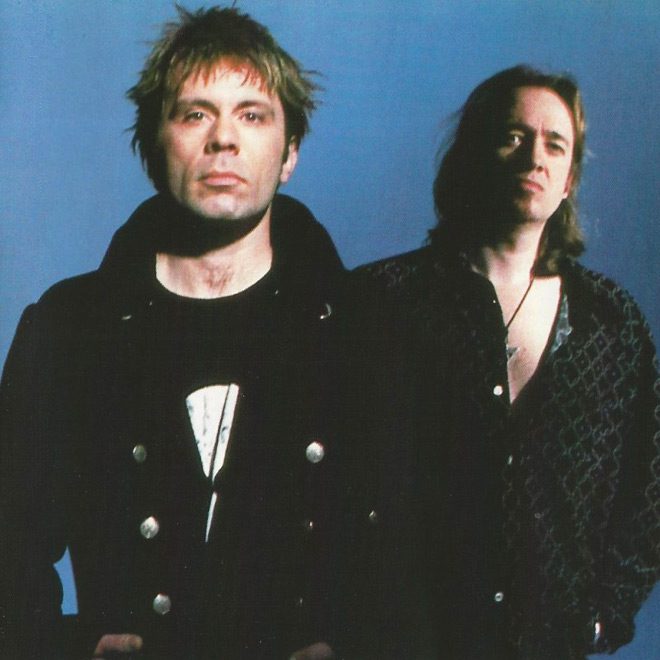
Bruce Dickinson and Adrian Smith started making heavy metal music together again in 1997, at a time when many fans felt that the quality of Maiden’s output reached an all-time low.
One should obviously give Dickinson’s solo music with Roy Z a fair shake as its own entity, but at the same time it’s impossible not to think of a certain other band when you hear Accident Of Birth: Heavy metal riffs, screaming solos and harmony guitars, singalong choruses, fantastic lyrics sung by Bruce in his patented air-raid style, melodic and groovy leads by Adrian, and even some galloping rhythms…
Dickinson would never match Maiden in commercial terms, even when his music outshone theirs and Maiden were at their lowest commercial point ever. He would not sell as many records or concert tickets, the name power of the Iron Maiden legacy putting him in a similar situation to what Roger Waters experienced in competing with Pink Floyd in the 1980s: The mothership will always be bigger.
But what Dickinson did achieve, by design or not, was alerting the metal community to the possibility that there was a better Iron Maiden to be had, somewhere down the road. For the time being, though, Steve Harris’ current band had an album to write and record, with Blaze Bayley and Janick Gers in the spots previously occupied by Dickinson and Smith.
BACK TO THE BARNYARD
In the realm of Steve Harris, the bucolic idyll of Sheering in Essex, Iron Maiden had apparently achieved a state of artistic and commercial independence that few bands can even dream of. Harris was seemingly unruffled by the downward spiral of Maiden’s fortunes and standing, insisting that his band never tried to be “current, or retro or anything. People will either love this kind of music or hate it, but we just take each song in any direction that feels natural.”
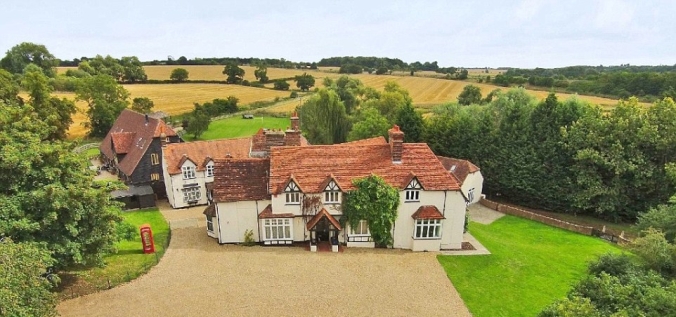
Freedom? Harris’ haven North of London. His Barnyard Studios, located in the brown barn at the back of the complex, is where Maiden did what Harris wanted in the 1990s.
In the summer days of 1997 Iron Maiden got back to work in the comfortable cocoon of the Barnyard, Harris’ own studio, to build songs for their eleventh studio album. This record would be the second with Bayley on vocals, and it was once again produced by Harris himself, as The X Factor had been, in conjunction with engineer Nigel Green.
A very important person in the camp, manager Smallwood, was not pleased with this set-up at the time, later telling Chris Ingham in the official Maiden biography Run To The Hills:
“I wasn’t happy having Steve producing those two albums. My view has always been: you write the songs, you lead the band, so it might be good to have a bit of objectivity and a bit of help in there.”
Rod Smallwood
Around the time that the album was made, the Maiden bassist and leader evidently felt a need to counter accusations of control issues and a lack of flexibility that had frequently crept up in the years since his split with Dickinson:
“Despite what some ex-members of the band would have you believe, I am open minded. Fans have always been secondary. I don’t mean that in a bad way, but if you don’t put your own enjoyment and satisfaction first, you’ll end up rewriting The Number Of The Beast ten times over because that’s their favourite song. I’m up for doing most things song-wise … but they have to be good ideas.”
Steve Harris
And who would be the ultimate arbiter of whether something was a good idea for Iron Maiden or not? Steve Harris, of course, who by this point in 1997 had no creative rival. Adrian Smith, Bruce Dickinson and even producer Martin Birch had been long gone, replaced by the much more dogmatic Gers, Bayley and Green.

The X Factor album and tour had seen Steve Harris consolidate a line-up of Iron Maiden that would defer unquestioningly to his ideas of right and wrong.
Half the songs for the new record was written by Harris alone, ranging from the uplifting tones of The Clansman (set to become a proper Maiden classic with the passage of time and a different line-up) to the disconcerting first single The Angel And The Gambler. In between those were the slow-burning and lyrically more mature efforts of The Educated Fool and Don’t Look To The Eyes Of A Stranger. A fifth track, the short and catchy second single Futureal, added lyrics from Bayley to music and melodies from Harris.
With the band leader also chipping in heavily on the primarily Dave Murray-driven numbers Lightning Strikes Twice and When Two Worlds Collide, this was clearly the most Harris-centric Iron Maiden record of all time when his production responsibilities and studio ownership was also taken into account.
Most curious in retrospect is the fact that Janick Gers has just one credit on the album, co-writing the ballad Como Estais Amigos with Bayley, where the guitarist provides one of the album’s precious few goosebump moments in the track’s guitar melody/solo middle section. Puzzlingly, this is the only Maiden project since 1992 where Gers has no co-writes with Harris at all.
The record that would become Virtual XI (early fan club information gave the title as Virtual Eleven) was rushed into recording in the late summer of 1997, when only these eight tracks were just about ready to go. If Blaze had felt that the recording of The X Factor had dragged on indeterminably, his second Maiden album would happen much too fast for his liking.

Artist Melvyn Grant replaced Derek Riggs with his artwork for Fear Of The Dark in 1992, and was invited back for Virtual XI in 1998.
At the time Bayley seemed cheerful that the album was “a lot more spontaneous from the recording point of view because we had much less rehearsal and we attempted to get the songs on tape a lot earlier than we did on The X Factor.” But in retrospect he would regret the speed of the process, suggesting that Maiden might have made some of the songs sound better if they had more rehearsals together.
Murray stated that the recording of basic tracks in late summer 1997 took a mere three weeks to complete. By September work was being done on vocals, lead guitars and synth overdubs, before Harris and Green entered into mixing and mastering the record in late 1997.
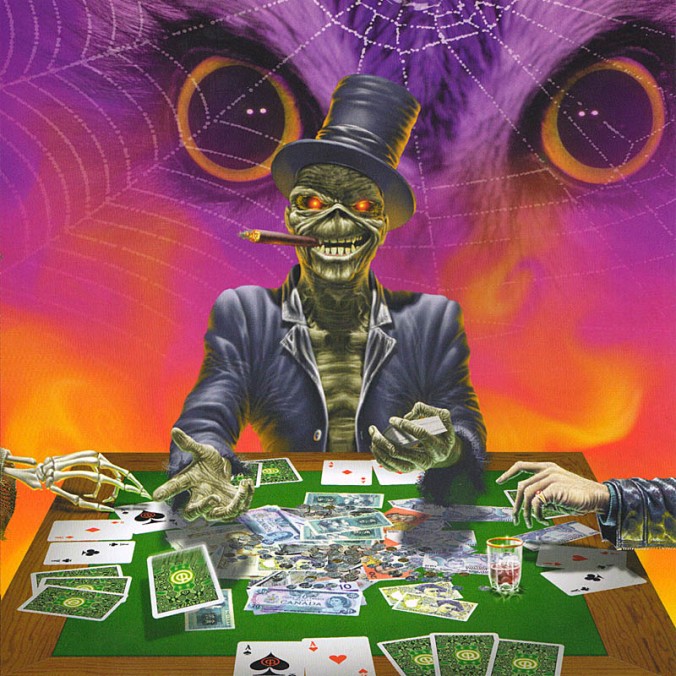
One of the underused Derek Riggs illustrations of 1998, this one connected to the concept of The Angel And The Gambler. Maiden and management would prefer amateurish computer graphics for much of the Virtual XI campaign, presumably in anticipation of their long-gestating computer game.
Martin Birch had, by his own admission as well as those of the band, never interfered with Maiden’s songwriting. His job was to be the mirror that reflected the band in the best possible light. Whatever music the band brought in was put on the record, while Birch worked to capture their sound and facilitate great performances.
It is therefore wrong to suppose that Maiden’s music would have been different with Birch as producer in the mid-1990s, but it is surely accurate to assume that the sound of their records in the 1993-1998 period would have been better with him at the console. After all, Fear Of The Dark was recorded by essentially the same band in the same studio, but it sounded much better than Virtual XI would do.
For whatever reason, Harris and Green seemed unable to provide a compelling production for the struggling Maiden of the Blaze Bayley era. It was obviously irrelevant whether they spent a long time on a record, as they did with The X Factor, or not, as was the case with Virtual XI.
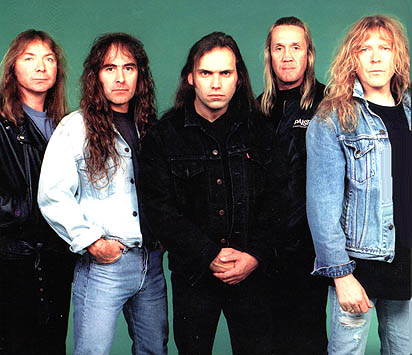
The 1998 Iron Maiden line-up, shot by Simon Fowler in front of the greenscreen where computer graphics will make Virtual XI era Eddie appear: Murray, Harris, Bayley, McBrain, Gers.
In the end, as Blaze recently said, “We just ran out of time. It was just a practical thing.” The 1998 tour was prepared well in advance, unlike the last-minute scramble for bookings that had plagued the previous tour for The X Factor, and so the band had a definite deadline for the album this time around. Which means that their pace of working in the studio to get an album ready for a tour more closely resembled the Maiden routine of previous eras.
It’s likely that manager Smallwood and booking agent John Jackson also felt a little more confident about what kinds of venues Maiden could hope to fill this time around, compared to the uncertainty that preceded the first tour with this line-up in 1995. Iron Maiden would hit the road in Europe in the spring of 1998 on the Virtual XI World Tour, before heading to North America for a summer tour that would ultimately spell the beginning of the end for the Blaze Bayley era.
VIRTUAL SELF-DESTRUCTION
A string of decisions in the 1990s led Iron Maiden to the point in late 1998 when Bayley was dismissed and Dickinson was asked to return. A number of other major changes in the Maiden operation would happen at the same time, and many of them seemed to be a reaction to the band’s current state of affairs: Iron Maiden wrote and recorded albums in Harris’ studio, they were also produced by Harris himself, Harris wrote the decisive bulk of Maiden’s material, and Harris had championed Bayley as part of the long-term aesthetic direction for Maiden.
It could be argued that these choices were accumulatively self-destructive, possibly artistically speaking and definitely in commercial terms. On the other hand, it is important to note that Harris never wanted Smith or Dickinson or Birch to pack up and leave in the first place.

Steve Harris, shot by Ross Halfin in 1986. In that decade Harris and Maiden would seem to be infallible. 12 years later, with the making of Virtual XI, Harris would be in complete control of Maiden’s destiny. But did he really want to be?
Virtual XI was released on 23 March 1998, preceded by The Angel And The Gambler as lead single and video. Behind the scenes Smallwood argued that Futureal would be a better choice, but Harris was by now the lone arbiter of what was right or wrong for Maiden to do. After all, Smallwood never had any say about the music, that was part of the deal.
So when Smallwood butted his head against the Maiden leader, arguing against the single choice and also the choice of Harris as Maiden’s producer, Harris would not budge. At least not yet, not while there was a chance that the new album could actually turn things around for Iron Maiden and redeem Harris.
But as a taster for the album, there was little hope that The Angel And The Gambler could attract much positive attention, as the manager seems to have been aware. For those who were curious about what Maiden would do in the wake of The X Factor, disappointment would be a common reaction to Virtual XI: A thin and powerless sound, flat guitar tones and no helpful vocal production, a lack of inspired songwriting. Even the visuals of the album booklet and the single artworks and packages for The Angel And The Gambler and Futureal indicated a directionless project.
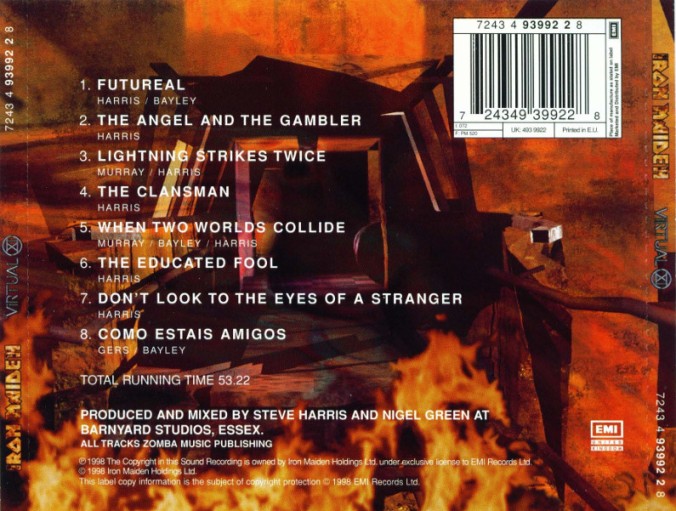
As the back of the CD tells us, pictured above, Virtual XI was heavily dominated by Steve Harris, more than any Iron Maiden album before or after. He produced the album in his own studio and wrote most of the music and lyrics. Even Janick Gers, who co-wrote much of The X Factor with Harris and Bayley, only wrote one track for the follow-up.
For better or worse, the condition of Maiden under what Dickinson has recently called “the spell of papal infallibility” when discussing it in his autobiography, the notion that Steve Harris always knows best because, well, he is Steve Harris, was about to be put to the ultimate test.
Click here for our review of Virtual XI!
Bayley remembers Harris suggesting that they build the visuals of the album and tour around the upcoming football World Cup in France in the summer of 1998. “Steve is a huge football fan,” Bayley recalled, “and he said, ‘Why don’t we base all the artwork and everything around the World Cup?’ and I said, ‘Why not? We could have a virtual eleven.’ That’s where the title came from.”
McBrain would recently remember it fondly as an “amazing promotion scheme, the football teams and stuff, Steve was in his glory.” But this apparent collapse of creative thinking would do nothing for Maiden except produce headache-inducing artworks and band pictures:

Surely any decent art designer’s worst nightmare.
Aesthetics aside, the most overtly self-destructive behavior that the Maiden camp indulged in at this time was probably in the build-up to the album and the 1998 world tour. In September 1997, as Harris reported that mixing of the new album was getting close, the Iron Maiden website gave this update on what to expect from the next tour:
“Rumour has it that Maiden will return to the massive shows of the 80s with huge production, lighting and enough pyro to blow away a fair size stadium. Their legendary maniac of lights and production, the aptly named Dave Lights, has returned to the fold after a self-imposed exile of almost 10 years. Dave was responsible for the legendary and massive shows for the Powerslave, Somewhere in Time and Seventh Son tours. The band are taking special insurance against Dave blinding or deafening fans and against themselves being blown up, which has happened in the past with various degrees of severity.”
Iron Maiden news update 18 September 1997
What would Maiden fans imagine based on this?
Band and managment explicitly bring up the awesome specter of their classic 1984-1988 stage shows. They state that this will be a “massive” show, with a “huge” production, including stadium-levelling amounts of pyro. They also announce the participation of Dave Lights, who did their lighting and effects in the 1980s.
Add to this the potential for setlist surprises that Harris himself talked up at the time. The official Maiden biography by Mick Wall was timed to coincide with Virtual XI, and it quoted Harris saying that, “I think we can do anything we like now. I mean, Blaze wants us to do Phantom Of The Opera. He loves that, and we may well do that on the next tour.”
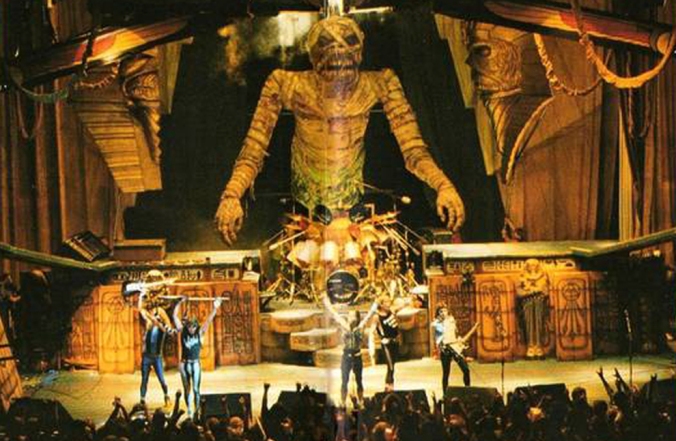

Just a little reminder of what Dave Lights used to do.
And … nothing.
Dave Lights was gone before the tour even started, and a decade later he explained the behind-the-scenes anticlimax of the 1998 Maiden tour that never happened:
“Iron Maiden asked me if I’d come back and re-create the shows that Maiden had done in the 80s, as they were planning to take the ‘classic’ set back on the road. I was pleased to be involved with that, and put the best part of four months’ work into designing the set, costing the equipment to within the specified budget, and getting all the plans drawn up for the stage production.”
Dave Lights
This must have been in 1997, as the band was ensconced at the Barnyard working on their new album. Lights went about his business with apparent care and excitement, but would feel his enthusiasm come crashing down when he was called to meet with tour manager Dickie Bell as the tour’s kick-off was drawing nearer.
“Dickie told me that they had changed their supplier of lighting equipment, and presented me with a list of what he wanted me to order from the new company. I handed the list back to him and said, ‘I’m sorry, this is not the same project you asked me to work on, and I’ll be sending you a bill for wasting four months of my time.’ It was even more annoying that they’d used my name in the pre-tour publicity when the stage show that they took on the road wasn’t mine.”
Dave Lights
What fans got instead was this:
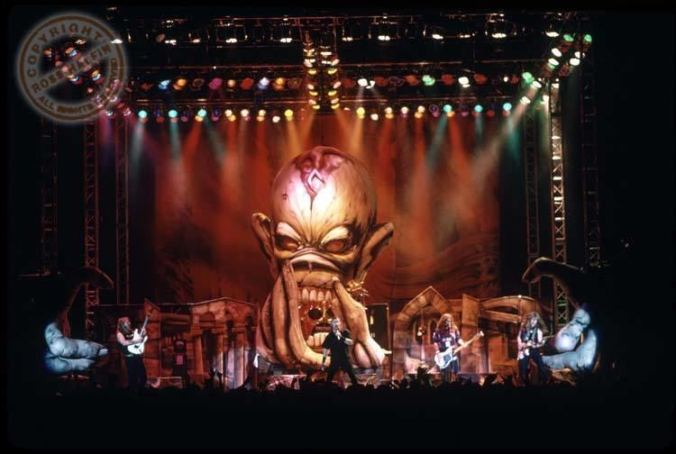
Iron Maiden live on stage in 1998, photographed by Ross Halfin on the Virtual XI tour. The set had hints of Somewhere On Tour about it, mostly the inflatable head and hands, but in a very ugly and confusing way. And there was no sign of pyro or something deep like Phantom Of The Opera.
Expectations were well and truly shattered.
It is not completely clear what Lights means when he says the intention was to “re-create” the “classic” set. He might specifically mean a new version of something like the Powerslave show, but how likely would that be when the band were unable to perform much of the relevant material without Dickinson or someone with the same vocal range? Did Lights work to a proposed setlist that ended up not happening once the band started rehearsals? Was the 1998 tour, set to go tandem with the launch of Maiden’s computer game, originally intended to be more like what Maiden would do in 1999 when Dickinson returned?
Even if Lights simply means to say that the type of show was going to be similar to the 1980s productions, like the official update clearly stated, the outcome was as disappointing for the fans as it was for him. The Virtual XI stage set and production was one of the least impressive shows Iron Maiden ever took on the road.
To be fair, Maiden did bring out Murders In The Rue Morgue for at least one show very early in the tour, a big surprise, but overall the setlist was also utterly disappointing for most of the tour: No catalog tracks that had not already been featured on the previous tour, a bewildering reluctance to dig deeper into the Blaze-ready Di’Anno material, and an overdose of songs from The X Factor and Virtual XI.
Bayley has recently stated that he lobbied for Maiden to include the relatively singer-friendly Still Life in the set, a Piece Of Mind (1983) jewel which is one of the less acrobatic Dickinson tracks from the band’s classic era. But no such thing was forthcoming.
It felt as if Maiden’s own enthusiasm had dwindled to disillusionment even before the tour started.
AT THE END OF THE ROAD
After just over a month on the road in Europe, Iron Maiden headed across the Atlantic for the North American leg of the tour. The opening US show took place on 26 June 1998 at the rather small Riviera Theatre in Chicago, a far cry from the type of venues Maiden had been accustomed to in their heyday, as Bayley himself would point out.
Some shows on the leg would be in considerably bigger places, but adding to Maiden’s woes was the cancellation of two weeks of concerts in late July, an unfortunate repetition of what had also happened on their previous North American tour in 1996. The reason for dropping shows, then as now, was Blaze Bayley’s vocal problems, officially reported as being an allergic reaction to pollen.

Blaze fronting Maiden on the Virtual XI World Tour, photographed by Adam Kozak.
Ironically, Bayley would praise the working conditions he achieved on stage with the switch to in-ear monitors on the Virtual XI tour, and lament the problems with stage sound that he had experienced earlier. In fact, his issues with monitoring on The X Factour, as recalled to Bayley biographer Lawrence Paterson, seemed to mirror earlier complaints made by Adrian Smith about Maiden’s onstage sound:
“I’d say to Dickie Bell that I’d like to go and do my own little soundcheck sometimes, listen to the monitors and get everything sorted out. I’d try to get as much set as I wanted but the monitor guy would then go and change everything. I said on more than one occasion that this monitor guy is not working for me, I can’t get the tools I need for the job, and he doesn’t listen to what I say.”
Blaze Bayley
Blaze’s frustration would finally dissipate with the arrival of a new monitor engineer and not least the precious in-ear monitors, basically hi-fi earplugs, in which he could get the mix he wanted without bothering anyone else on or off stage. But judging by bootleg recordings from the 1998 tour this did not improve his vocal performance noticably, and he would still struggle heavily with the Dickinson material in the set:
As authorized Maiden biographer Mick Wall phrased it, “Maiden’s voice was slowly growing weaker”, both “physically and metaphorically”.
But could this be a surprise to anyone? Bayley’s struggle was surely inevitable: Maiden had decided to ignore the fact that he couldn’t match Dickinson’s range, and they also refused to tune down their instruments in order to lower that range and help Bayley hit the target. As Blaze would later say, “I was never going to be my best. The songs were never in the right key.”
One person in particular would know better than anyone else what it took to be the singer and frontman on an Iron Maiden world tour: Bruce Dickinson himself. He would always be supportive of his successor, saying in 1994 that, “Maiden are a world-class band and they would not have picked him unless there were some serious good vibes going on. I spoke to Janick the other day and he said that he had been very sceptical about all these guys coming in, but with Blaze it was great.”
Recently, however, looking back on Maiden’s radical change from himself to Bayley, the long since returned Dickinson would recall:
“I was, like, ‘Wow, I hope this works out. I thought it would probably be more difficult than he could imagine. […] I thought ‘Wow, they could have picked somebody with a voice that could do what my voice did.’ But they picked Blaze. Obviously, they picked somebody different, but that came with its own set of challenges. I just wondered whether anybody in the management was really giving anybody any serious words of truth on how hard this could be.”
Bruce Dickinson
Bayley actually credits Rod Smallwood with trying to help him out when things got tough on tour, but the manager had not picked the singer and could obviously not coach him into mastering the vocal range of The Trooper or Hallowed Be Thy Name.
Responsibility for the situation rested with Harris.
In the end, it seems plausible that Smallwood would set wheels in motion in the summer of 1998, when Maiden cancelled a string of US shows on account of Bayley’s illness. Harris would later admit to biographer Wall that there might be more profound issues than allergies at the root of the problem:
“Being the singer for Maiden is very tough. You’re talking about two hours, five nights a week, for months on end. And singing the stuff we do – that’s very, very tough, and Blaze did find it tough. Some nights, he was great, and other nights, he … wasn’t so great.”
Steve Harris
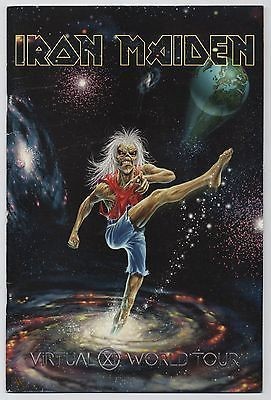
The Virtual XI World Tour would be Blaze Bayley’s last with Iron Maiden.
Further putting Maiden’s 1998 record and live performances in an unenviable position of comparison was the release of Bruce Dickinson’s The Chemical Wedding in September that year, another metal record where the singer teamed up very successfully with Roy Z and Adrian Smith. After years of now-and-then Maiden bashing, the singer’s newest attack on his former band was a more sophisticated like this, lads.
By the failure of Maiden’s American tour in the summer of 1998 Smallwood must surely have known that they had reached the end of the road with this version of Iron Maiden. “My job is to make the band as big as possible,” he would later say matter-of-factly. As Dickinson and Smith hit the European club trail with The Chemical Wedding in late October, and Harris’ mothership band was limping towards the end of their Virtual XI tour, time was up for Blaze in Maiden.
Rod Smallwood had started working his two managerial charges, Iron Maiden and Bruce Dickinson, towards reconciliation.
THE MANAGER’S HAND
“It didn’t feel right,” Bayley said. “There were some funny vibes at the end of the tour.” Indeed, when Maiden played South American shows in early December 1998, the band had already decided that Bayley had to go.
“There was talk and worry about Blaze because of the inconsistencies onstage, and it was getting to the point where something had to be done. I still stand by the albums we did together, particularly The X Factor, which is still one of my favourite Maiden albums. It’s just a pity it didn’t work out better on the road.”
Steve Harris
Quite how Harris had expected it to work out is difficult to understand, given that everyone involved knew as far back as Blaze’s audition in 1993 that he could not sing the Dickinson material very well. If this was a combination of hope (that time would make Bayley better) and denial (about his lack of vocal range), by late 1998 Harris would acknowledge that it had played itself out.
At the end of the tour, even as Blaze felt that “something was definitely wrong”, he did not know that talks with Dickinson had been ongoing for a while and that Smallwood had convinced Harris of giving a reunion with Maiden’s former singer a chance. In time-honored Maiden tradition, Dickinson’s return would be sealed behind the scenes before Bayley was fired.

There is no question that Blaze was doing his best as Maiden’s singer, but the fact that his voice did not fit much of the classic Dickinson material was proving impossible to escape.
In the September 1997 update that hyped a return to the 80s productions, Maiden also dismissed ongoing rumors of Blaze leaving the band and Bruce rejoining. While it was obviously not true at the time, the very fact that Maiden’s people adressed it speaks volumes about the relative weakness of Maiden’s current position in light of their past. And about one year later this change of singers was exactly what Smallwood was working towards.
The pressure would hit Harris from several sides. He must certainly have known that Maiden had diminished. Indeed, he stated in a Metal Hammer interview at the time that, “I can’t see Iron Maiden ever becoming massive again.” But at least two people in the camp would suggest to him that Maiden could.
Smallwood approached Dickinson and Harris separately in the fall of 1998.
“It was Rod who took me aside and said, ‘How do you feel about putting it back together?’ I said, ‘Well, you know, there’s a couple of things that concern me, but 90 per cent of things I think are massive opportunities.”
Bruce Dickinson
The singer didn’t drag his feet and would confirm his interest in a reunion as soon as he “started getting smoke signals from the Maiden camp”, as he said. Harris on the other hand would need more time to consider the idea. “Steve’s a very strong character and he takes things personally,” Smallwood said. “He needed time to think about that.”
Drummer McBrain would be pushing for a change of singer at the same time. In fact, Bayley speculates that McBrain started obsessing over concert recordings off the soundboard where Bayley did not sound very good, and that he brought those to Harris with concern.
At some point in November 1998, after the European leg of the tour and before Maiden’s shows in Japan that month, Harris would decide that it couldn’t hurt to meet with Dickinson to talk about a possible reunion of forces. McBrain recalls being in a sake bar in Roppongi, Tokyo when Smallwood told him that there would be a band meeting with Bruce when they came back home.
“That Virtual XI tour was mixed emotions for me; some nights it was absolutely amazing and other nights it wasn’t so. After we had the first meeting after we got back from Japan on that Virtual XI tour, and it was decided that we couldn’t carry on with Blaze, it all fell into place. All the stars aligned.”
Nicko McBrain

Iron Maiden getting ready for the show towards the end of Bayley’s time with them.
We will get into that secret meeting in the next chapter of Maiden History, but it seems to have happened sometime in late November, possibly Sunday 29 November, the day before Dickinson started his UK solo tour. In any case, the change was definitely decided before Maiden headed out for their final shows with Blaze Bayley in South America.
“At the end of the day, Blaze wasn’t what was required for Iron Maiden. If you build a legend like Maiden, you’ve got to keep it a legend. It’s my job as manager to make sure everything’s the best it can be in every possible way. And in the end, Steve accepted that.”
Rod Smallwood
It is sobering to realize that at this point, in Brazil in December 1998, everyone on stage except Blaze knew that he was out of the band:
Steve Harris and Bruce Dickinson had agreed to reunite.
It was time to fire Blaze Bayley.
“I think they let me have a decent Christmas before making the break,” remembers Blaze. He had put the strange vibes at the end of the tour out of his mind, and in early January 1999 he was called to Smallwood’s London offices for a band meeting that Blaze thought would be about the year of work ahead for them.
In a way it was.
“I got there and there was a meeting in the boardroom. Everybody was there and the whole feeling was down and depressed and you could instantly see that something was very wrong. And then, that was it, I was out. I couldn’t believe it. Rod was the one that said it and nobody could look me in the eye … and that was it … no more … I was out. I looked at Rod and I asked, ‘Is Bruce coming back?’, and he couldn’t look me in the eye. He just said, ‘Yes.’ “
Blaze Bayley
Blaze left the meeting as Iron Maiden’s ex-singer.
Five years earlier he had celebrated joining Maiden all alone in his apartment, at Christmas 1993, and now he was facing the lonely task of building a new career post-Maiden in 1999 and beyond.
Harris later recalled to Bayley’s biographer that he found the situation very difficult to deal with:
“It was heart-wrenching. I really like the guy, I really get on with him so for me personally it was really tough, a really tough decision. But having said that, I think it was the right decision. At the time, if I’m honest, I wasn’t 100% sure it was the right decision, but you have to go with your gut feeling and ultimately I felt deep down that it probably was. But that’s not really about Blaze, that’s because we didn’t want Bruce to go in the first place, we didn’t want him to leave.”
Steve Harris

Steve Harris had enjoyed working with Blaze Bayley, and he found it very hard to part ways with the singer in January 1999. But the cause of Maiden, championed by Rod Smallwood, needed Bruce Dickinson.
The bottom line is that Smallwood was right. Iron Maiden had shrunk. Virtual XI was the first Maiden album to sell less than 1 million units worldwide, but the declining attendance figures for concerts and the lack of setlist flexibility available to them because of their singer’s limited range were likely much more decisive in making a change. And there was only one obvious way to rectify the situation: Get Bruce back.
Certainly, Blaze himself sees the importance of Dickinson singing for Maiden as essential to the big picture, and to his eternal credit he has always spoken highly of Maiden. In retrospect he also seems realistic about the state of affairs during his time with the band, outlining the situation to his biographer Paterson:
“What I felt was that we had lost a lot of fans after The X Factor. A lot of people didn’t like the new line-up, didn’t enjoy the album, might have given The X Factor a chance but then didn’t come back. But I did feel that those people that came to Virtual XI knew exactly what to expect, exactly what they were getting, and they were hardcore fans.”
Blaze Bayley
Bayley might harbor regrets that he never got a third chance at making a Maiden record, and he keeps suggesting that such a what-if could have turned everything around. But he has also stated that, “They had to make a business decision. Getting Bruce back, it was the right thing to do. Look at what they’ve done since. I don’t think anything bad of the guys.”
Look at what they’ve done since, indeed.
Sources: Kerrang! issue 487 (March 1994), IronMaiden.com News Update (18 September 1997), Run To The Hills: The Authorised Biography of Iron Maiden (Mick Wall, [1998] 2004), Classic Rock issue 33 (November 2001), Metal Hammer’s “Iron Maiden: 30 Years of Metal Mayhem” (2005), Dave Lights Interview at Get Ready To Roll! (27 October 2007), At the End of the Day: The Story of the Blaze Bayley Band (Lawrence Paterson, 2010), Iron Maiden in the Studio (Jake Brown, 2011), Classic Rock’s “Iron Maiden: Hope and Glory (Paul Elliot, 25 May 2011), Classic Rock’s “The Story of Iron Maiden’s Forgotten Man” (Paul Elliot, 14 April 2016), What Does This Button Do? (Bruce Dickinson, 2017), Iron Maiden Album By Album (Martin Popoff, 2018), Classic Rock issue 257 (December 2018), “Iron Maiden’s Steve Harris Says ‘Loads of People Are Really Enjoying’ Blaze Bayley-era Albums More Now (Blabbermouth, 2019), Blaze Bayley Interview With EON Music (Eamon O’Neill, March 2020), Rock Candy issue 19 (2020), Nicko McBrain Interview with TVMaldita (July 2020), Bruce Dickinson quotes in Metal Hammer (March 2021).
Great entry! Can’t wait for the next one! Thanks!
Thank you!
I love it. I just love this blog.
A great read! Never ever know about Dave Lights coming back and leaving. He was a master mind of those 80 tours.
Lot’s of great insight here. Awesome..
Thanks, deKE!
Grymt jobb mannen!!!
Tack så mycket!
Great! The painful but full of the truth article.
Thanks!
Iron Maiden is made for Bruce Dickinson. The guitar harmonies, storytelling lyrics, etc. are in need of an energetic and dramatic performer. Blaze was not that guy for the Maiden style of playing and performing. As many have said, the band could have returned to Dianno era songs that would have helped Blaze, but he was never going to deliver the vocals and showmanship needed to promote the Dickinson era songs.
As always, a pleasure to read your thorough articles.
Steve’s decision to hire Blaze is still hard to comprehend today.
Having said that, I’m one of those fans that actually liked both The X Factor and Virtual XI from the start.
Thanks! I tried hard to like them, I bought all the albums and singles and tickets and shirts and so on. Looking and listening back is different, though.
Sure, I agree with you.
Maybe I should’ve mentioned that I became a Maiden fan after the reunion with Bruce and Adrian.
So, for me it was different than for the fans who were listening to Maiden in the 80s and 90s.
I really enjoyed reading that. Very well put together. Love your website – up the Irons!
Thanks, glad you like it!
It would have been interesting to see what type of album IM would have made after FOTD if Bruce had not left. I feel THE X Factor musically and lyrically was a decent album, but the production was dry, thin, and hollow. It was kind of like A Matter of Life and Death, with are darker feel, but without great production. I just don’t think Steve would have made that record with Bruce still in the fold at that time. I don’t think Virtual XI ever gets made with Bruce on board. It’s really a bad album all around, with few exceptions in the songs. Ultimately it worked out because if Bruce hadn’t left and returned, it’s doubtful Adrian would be back. It took that Dickinson and Smith collaboration to get him back into the conversation of rejoining. Adrian was desperately missed.
UP THE IRONS!!!!!!!!!!!!!!!!!!!!!!!!!!!!
Really enjoyed reading this. When is the next on coming?
When time allows. Probably sometime next year.
Really looking forward to the next one. I really like the writing style and how everything is put together. Also, if there’s anyway in which I can support this website, I’d be happy to. Just let me know.
Thanks for the kind words, Dave!
The Blaze era was when I got into Iron Maiden, so emotionally speaking the albums are special to me – the X Factor was the first album that I bought on release day, and the first time I saw them live was on the Virtual XI tour.
I still enjoy listening to The X Factor, though Virtual XI doesn’t get much action in my headphones now. TXF is (in my view) the best of the four 90s albums, and NPFTD is probably the worst. But even I would say that it’s laughable to try and compare any of them to Seventh Son, Powerslave etc. I honestly feel that the loss of Adrian Smith was more significant to the overall quality than Bruce’s departure.
They really didn’t help Blaze with the setlist, he would have been much better suited to other songs than the ones they made him sing. I’d have been doing cartwheels if they’d played Killers, Phantom of the Opera, Still Life… They’ve got some top notch songs that didn’t and don’t come out much, which he’d have had a better chance on than some of the stuff they always play. It would have been really interesting to hear if they had tuned down to D as well. He’d have been in a better place vocally and the overall sound would have been that notch heavier.
I don’t know if we’re allowed to mention such things here, but Blaze’s debut solo album “Silicon Messiah” is brilliant. Released about the same time as Brave New World, you could argue (without it being totally ridiculous) that it’s better than anything IM have done since 1988.
Blaze Bayley – top man, decent singer, probably never the right guy for IM, but not really helped in that by the various mistakes that other people made during his tenure. A missed opportunity, really.
And why on Earth would you not be “allowed to mention such things here”…?
No idea. Have you heard/ do you like Silicon Messiah, Tenth Dimension etc? Those first two are very good IMO, but things get a little more patchy in his post IM output after those.
I thought Blaze sang much better on Silicon than he had done in Maiden just a year or two before. Then again, I suspect there’s a fair bit of autotuning going on there. In any case, as you said, it’s bewildering that Maiden would neither tune down for him or pick tracks like Killers and Phantom for their set.
I wonder if they’re even now a bit reluctant to play too much Di’anno material because it is also Clive Burr material. Obviously they have to play a few songs from TNOTB and something would be a bit off if they didn’t play Iron Maiden…
Maybe it’s nothing of the sort, and when you’ve got more than 10 albums to work with some will not get the setlist love they deserve.
Well, there was the Early Days tour with loads of Di’Anno/Burr material. There are always two or three tracks off Beast on any tour. Then there’s Iron Maiden, regular. Running Free and Phantom Of The Opera have been semi-regulars since 1999. And Wrathchild has been featured much more than some fans like. So I don’t really see that.
When’s the next chapter of Maiden History due? Fascinating work this. Really interesting.
Thanks! Due whenever time allows. Those articles are not quick to write.
Great stories! I saw Maiden with Blaze on both TXF and VXI tour. The VXI show was surreal because the gig had been advertised on the local radio a month before as “The Metal Monsters” outdoor show at a car race track in Mcallen ,Texas with Maiden,Dio and WASP.
A week and a half before the show it was announced that the show had been moved to a small indoor venue called The Roadhouse in San Benito, Texas which is a tiny little town with as many cows as there are people living there!
The Roadhouse was a tin barn capacity about 500 hundred I would say. WASP did not play .I felt sad to see Maiden in this less than glamorous setting and Blaze looked uncomfortable and lacking in confidence onstage. To their credit, the boys looked like they were giving their full effort as did Dio. I don’t think anyone who was there that night was surprised to hear that Bruce and H were coming back.
It felt like watching an old friend with a new wife -you want to be polite and supportive but it just doesn’t feel “right”. When they released the publicity photos with Bruce and Adrian back in the band I smiled because it felt like the universe had corrected itself!
Thanks, Rich! Wow, that was quite an experience of Maiden’s decline you had there… I saw Maiden in Oslo on The X Factour, and they played the smallest venue they ever did in my country. I was 17 at the time, so I was still excited to see them, had only seen them on the Fear Of The Dark tour previously. On the Virtual XI tour in 1998 I saw them in a pretty big venue in Stockholm, and at that point I lost hope that they could become great with Blaze. It was just not a good performance by any measure.
Fantastic review, mr.Bakke Andersen! As a big Blaze era fan and writter of the upcoming book about this period of Maiden, I want to ask you..what songs from Bruce era in your opinion would’ve been good choices for Blaze? Thanks for your answer! 🙂
Thanks, Mate!
Well, although I have always liked the barritone sound of Bayley’s voice, my major issue with his singing is the lack of range and the erratic pitch. It’s interesting to note that Blaze suggested the band do Phantom of the Opera (Paul era) and Still Life (Bruce era) without getting his wish, both tracks that would suit his voice way better than, say, The Trooper.
As for other Bruce era tracks that would suit him? Powerslave and Deja-Vu would possibly sit better with his range, but I still don’t think they would have sounded very good.
Good luck with your book!
Perhaps you Will not agree with me but in my opinion, he sang Afraid to Shoot Strangers better than Bruce and his covers of Heaven Can Wait and Fear of the Dark are quite good! He lacks some power on the higher pitch but still, very good! Powerslave is for me, type of the song that would’ve been perfect for Blaze, and same goes for Still Life.
I have one more question for you.I can confirm that Blaze did asked for tuning down half a step but Harris refused cause he was afraid of the reaction of the fans.What do you think what do you think what Maiden fans liked more, Bruces classics with Blaze, although slightly tuned down or droped classics and returning much of the Di’Anno material in the setlist? I have to ask you cause we know Blaze couldn’t sing most challenging material from Bruce and Maiden fans really knows their original sound.But on the other hand, many fans argued with me that without classics from Bruce, everything would’ve been even waaay more worse.Thanks for your time and opinion! 🙂
I have tried to compile an overview of the whole situation of hiring Blaze and not a singer with the proper range, and the subsequent refusal to tune down according to Blaze’s range, in the previous history chapter on 1994-1996. It completely blows my mind that Maiden got into that situation, and I feel sorry for Blaze. Still, I’m not convinced that he would have sounded good enough “slightly” tuned down, he would have needed a whole step or step-and-a-half down to manage something like Hallowed Be Thy Name, maybe even two whole steps from E to C. And this wouldn’t have helped with his erratic pitch, which I’m sorry to say that I find embarrassing most of the time, no matter what tuning.
Stuff Like 2 Minutes to Midnight, Clairvoyant and Evil that Men Do are half a tone beyond his range and timeless classics Like Hallowed, The Number of the Beast or The Trooper full Octave..In the Eb tuning, songs Like 2MtM, Clairvoyant and The Evil that Men Do would’ve been Within his natural range and most acrobatic stuff Within his screaming range..and although I agree D is the best key for Blaze, back then, due the reasons I Said, he could justify those song with the half a step down.
But as a writter, I respected Harris decision and for The X Factour I recommended this setlist:
Man on the Edge
Wrathchild
Remember Tomorrow
Lord of the Flies
Still Life
Blood on the World’s Hands
Afraid to Shoot Strangers
Powerslave
The Edge of Darkness
Sign of the Cross
Murders in the Rue Morgue
Phantom of the Opera
Heaven Can Wait
Iron Maiden
ENCORE:
Fear of the Dark
Prowler
Killers
What do you think?
Just looking for a place to say get well soon Blaze! I know TXF and VXI weren’t everyone’s cup of tea – they aren’t my favourite albums but they were the first ones to come out after I’d started listening to Maiden and the first two tours I saw so I’ve got a certain soft spot for them. In fact I’m listening to VXI as I’m typing this! Anyway I was really sad to hear of his health issues and wishing him a speedy recovery. I’ve seen him live with his solo band and Wolfsbane a few times in recent years and he’s been brilliant on every occasion. He was the wrong man for Maiden and all in all it was a bit a hospital pass to join them but he’s never complained in public and has had a whole hearted (if slightly erratic) solo career. They may have passed some people by but the Infinite Entanglement trilogy are three genuinely excellent metal albums (hammy voice acting interludes aside) and I’d recommend them to everyone reading this blog. Get well soon big gun, cheers from Dave
Wolfsbane did play outside the UK, including part of Europe and USA (1989).
Yes, showcases, certainly. Blaze is probably thinking about proper touring over time.